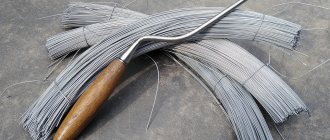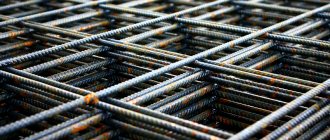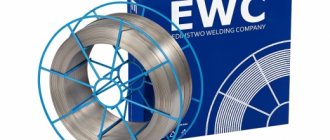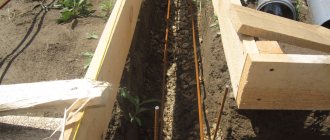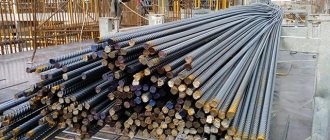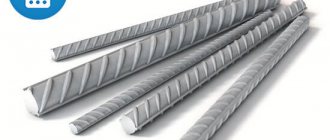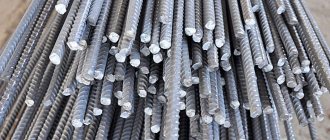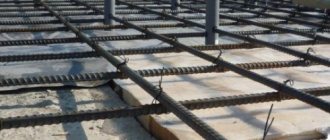8 years in the rolled metal market
We work with individual entrepreneurs, individuals, Management Companies and other organizations
We will deliver the products on time
Delivery throughout St. Petersburg and Leningrad region
Knitting wire is a type of hardware, made from low-carbon steel, has low cost, and its main purpose is connecting parts, linking knots, constructing fences, etc. It is most often used for tying reinforcement cages in monolithic concrete works. Let's consider which wire is suitable for tying reinforcement and how much tying wire you need to take per ton of frame. To correspond to its functions, it must be plastic, that is, easily deformed, and must not spring, that is, maintain a mechanically specified position.
Two types of wire
Knitting wire is produced from metal blanks by drawing. There are two main types of knitting wire: regular tinned and fired. To tie reinforcement in foundations and other reinforced concrete structures, the second type is used.
To prepare the wire, it is treated with thermal hardening, which gives it flexibility and resistance to the harmful effects of the environment, and also makes it less plastic, which greatly increases the strength of the material and, consequently, the wire assembly.
Stores offer galvanized and non-galvanized material. Both can be used to tie reinforcement, although galvanized binding wire (GOST) will be more resistant to aggressive environments.
This is interesting: Consumption of reinforcement per 1 m3 of concrete - how to calculate
Application and production technology
Wire for tying reinforcement is most popular in monolithic construction. With the help of concrete and reinforcement, buildings of the most unusual shapes are created, thanks to its technology and the integrity of the structure from the foundation to the roof. It is in this area that more than one object can do without the use of wire.
The wire is used for reinforcement of such reinforced concrete structures as:
- Foundations (strip, slab, pile).
- Walls, columns, beams and lintels.
- Stairs.
- Monolithic floors.
- Floor screeds.
The most important parameters of wire for tying reinforcement are flexibility and strength. It must provide a reliable connection of intersecting reinforcement elements, and at the same time be soft and pliable for quick work.
These characteristics are ensured by the properties of the material, production technology and subsequent heat treatment.
The material for production is low-carbon steel. Wire is a product of the process of drawing a workpiece through dies with a given diameter. Under the influence of pressure and in the process of plastic deformation of the workpiece, the steel structure is refined and improved, and a hardened hardened layer is formed on the surface.
However, after such a procedure, significant internal stresses remain in the metal, which do not allow the resulting product to bend; it will be rigid and brittle. Therefore, in order to be able to use the wire for knitting, it is subjected to heat treatment - annealing. During the annealing process, relaxation and stress relief occur. Thus, the result is a durable, easy-to-use product.
This is interesting: Knitting fiberglass reinforcement for the foundation: we reinforce it correctly
Purpose of hardware
Wire for connecting reinforcement plays a key role in the construction of monolithic concrete structures. The main purpose of this material is to link reinforcing elements into a spatial or flat frame. This type of product is used for the production of:
- chain-link mesh;
- ropes;
- masonry mesh;
- prickly hardware;
- to carry out packaging work.
Use of wire for tying reinforcement
This is interesting: A500C reinforcement assortment table
Advantage of wire over welding
When comparing welding technology with bonded welding, we note the following advantages of wire connection:
- ease of working with the material - the process of knitting reinforcement is feasible for everyone;
- performing reinforcement directly in the formwork;
- convenient adjustment of the position of the rods - if necessary, you can correct the geometry of the frame by untying several structural elements;
- absence of welded joints - when heated, the metal’s initial characteristics decrease, it becomes weaker, the weld is more susceptible to corrosion;
- affordable price.
The only disadvantages include the unsteadiness of the connected frame, but if you supplement the reinforcing structure with braces, it will become stiffer.
Methods for determining the required wire mass
To purchase metal products, you need to convert the resulting footage into kilograms. To do this, you can use an online calculator or table.
Table of mass of 1 m of binding wire of various diameters
| Diameter, mm | Weight 1 m, kg | Footage 1 kg, m |
| 0,6 | 0,00222 | 450,45 |
| 0,8 | 0,00395 | 253,17 |
| 1,0 | 0,00617 | 162,0 |
| 1,2 | 0,00888 | 112,6 |
| 1,4 | 0,0121 | 82,6 |
| 1,6 | 0,0153 | 65,4 |
| 1,8 | 0,02 | 50,0 |
| 2,0 | 0,0247 | 40,5 |
The minimum weight of wire products in coils and coils put on sale must comply with GOST 3282-74
| Wire diameter, mm | Minimum weight of wire in a coil or on a reel, kg | |
| Without cover | Zinc plated | |
| Up to 0.2 | 1 | — |
| 0,2-0, 6 | 2 | 0,3 |
| 0,6-1,0 | 5 | 0,6 |
| 1,0-2,0 | 8 | 2,0 |
| 2,2-3,6 | 12 | 5,0 |
| 4,0-46,0 | 30 | 10,0 |
| 6,3-10,0 | 40 | — |
The maximum weight of hardware in a coil is 1500 kg. Each skein should consist of only one piece.
Classification and varieties
Reinforcement wire is classified into varieties according to the following parameters:
- presence or absence of a protective coating;
- heat treatment;
- strength class.
Depending on the presence of a protective coating, the material is divided into two types: made of ordinary low-carbon steel and galvanized. The coating is applied by hot-dip galvanizing, which involves soaking coils of wire in baths of molten zinc.
data-ad-client=»ca-pub-8514915293567855″ data-ad-slot=»1955705077″>
Material with a protective coating is divided into two classes - 1C and 2C. The differences between them lie in the thickness of the galvanizing layer; in class 2C material, the protective layer is much thicker: for comparison - 155 versus 85 g/m
2
in wire with a diameter of 6 mm. An alternative to galvanized materials is MNZHKT wire made of a copper-nickel alloy, however, its use in construction is unjustified due to its high cost.
Galvanized wire VR-1
According to the type of hardening, reinforcing wire is classified into untreated and annealed (marked with the letter O). The essence of heat treatment is to heat the material to a given temperature in a blast furnace and then cool it. As a result of annealing, the crystalline structure of the metal changes and the internal stress of the steel is destroyed, which provides increased elasticity and mechanical strength of the wire.
Depending on the strength class, products are classified into two groups B-1 (regular) and B-2 (high-strength). The difference between them lies in the brand of alloys used; low-carbon steel is used for the manufacture of wire V-1, and steel with an increased amount of alloying components is used for wire V-2. Material B-2 is used to connect frames made of prestressed reinforcement, while class B-1 is intended for the installation of non-prestressed structures.
Dimensions and weight
The diameter of the material depends on the presence of a protective coating - galvanized wire is produced in diameters of 0.2-6 mm, without coating - 0.16-10 mm . From the factory, products are supplied in skeins (weight from 15 to 250 kg) or reels (500-1500 kg). The skein should consist of one piece of wire, the coil - no more than 3.
Here is a table of knitting wire weight 1 meter, BP brand, the most popular on the market:
- VR-1 (diameter 1 mm) - weight 0.012 kg;
- VR-2 (diameter 2 mm) - weight 0.025 kg;
- VR-3 (diameter 3 mm) - weight 0.06 kg;
- VR-4 (diameter 4 mm) - weight 0.1 kg;
- VR-6 (diameter 6 mm) - weight 0.23 kg.
A characteristic feature of the VR brand is the presence of corrugated walls, due to which the adhesion (adhesion) of the material to the reinforcement bars increases, which has a positive effect on the overall strength of reinforced concrete structures.
Wire "Cossack"
«
Recently, wire for tying reinforcement with rings, also called “Kazachka”, has become widespread on the market. It is produced in the form of lengths of 8, 10, 12 and 14 cm, at the ends of which there are rings for a hook for tying. Connecting reinforcement with “Kazachka” is carried out much faster than with a standard analogue, since there is no need to cut and independently form rings. The material is supplied in the form of spools consisting of 1-5 thousand pieces.
Knitting reinforcement with wire (video)
How to knit?
To assemble a frame from 10-14 mm reinforcement bars, you need to use wire with a diameter of 1.2-1.4 mm . If the material has poor elasticity, the coil must be kept in a fire for 20-30 minutes, and then allowed to cool at natural temperature. You can use products with a smaller diameter, but in this case, when making a connection, you will need to bend it twice.
You will need a special tool - a crochet hook, which can be manual or mechanical. You can buy a hand hook for 100-300 rubles, or you can make it from a trowel or paint roller, bending and sharpening their end.
Instructions for crocheting reinforcement
Reinforcing wire is knitted quite simply - a 30 cm long piece is folded in half, at a distance of 1/3 from the loop the wire is bent around the finger and tucked under the overlap of the reinforcement. A hook is inserted into the loop, after which the free end of the material is bent through the reinforcement and inserted into the hook bed.
Then, by rotating the tool, the connection is tightened. The number of turns of the hook is determined by eye so that the connection is strong enough, but does not overtighten.
In the process of manufacturing the frame of reinforced concrete structures, it is necessary to maintain a protective layer of concrete 3-5 cm thick. Here, instead of special stands, you can use cut rings of plastic plumbing pipes with a diameter of 4-5 cm.
Related articles:
Portal about fittings » Mesh » Wire » Nuances of using tying wire
How to calculate
It is necessary to calculate the wire consumption for connecting reinforcement individually. Construction experts give various recommendations for determining the average wire consumption. Some argue that one ton of base requires 10 to 15 kg of raw materials. Other craftsmen recommend purchasing 15–20 kg of knitting hardware for the same amount of metal.
Consumption of tying wire per 1 ton of reinforcement
In the case of the length of the segment required to form a knot, the opinions of professionals also differ. Some believe that a piece 10–15 cm long is enough to knit a knot, others believe that the required consumption is 30–50 cm for this formation.
The main recommendation is that the amount of wire for tying the reinforcement should be twice the obtained value. The increased consumption is due to frequent interruptions during the work process.
Settlement operations
Simple calculations allow you to calculate the consumption of tying wire for reinforcement with a fairly high level of accuracy. When calculating, the following characteristics should be taken into account:
Comparative table of the required amount of reinforcement and tying wire for different types of foundations
- diameter of main rods;
- thickness of knitting raw material;
- the number of nodes in which the tying should be carried out.
Increased consumption of wire material is observed at the intersections of several horizontal and vertical rods. In the middle part of the metal structure, knitting through the joint is allowed. All overlapping joints located at the edges of the structure are subject to mandatory strapping.
The length of the metal product required to form one knot is calculated experimentally - by performing a trial strapping.
Video on the topic: Crocheting reinforcement
Our production
- Armature
A widely demanded type of rolled metal in construction and the production of reinforced concrete products is reinforcement…
Wire VR1
VR1 wire is used to create a reinforcing frame in reinforced concrete and monolithic works...
How to calculate the amount of tying wire per ton of reinforcement
Calculation of tying wire for reinforcement is based on the following data:
- Construction type . For a heavy structure, the number of strapping elements will be greater than for light structures.
- Type of reinforcing bar . As the diameter of the main rod increases, the amount of binding wire decreases, and as it decreases, it increases.
According to SNiP data, the consumption rate of tying wire when assembling a reinforcing frame is 30 cm per connection unit or 4 kg per ton of reinforcement. To more accurately calculate the amount of material, it is necessary to calculate the number of joining points of embedded products. Based on practical experience, steel bars weighing 100 kg will require from 0.9 to 1.3 kg. The consumption of tying wire per 1 ton of reinforcement should be from 9 to 13 kg. To tie 1 ton of steel bars with a diameter of 28 or 32 mm, you will need about 7 kg of wire, 8 mm - 12 kg.
The most accurate data can be obtained by creating a trial harness. Or use the formula for calculating the length of one turn:
2 x 3.14 (Pi) x cross-sectional radius of reinforcement x 1.03
Count the number of strapping knots and multiply by the length of one turn with a margin. Please note that when transferring the rods you need to make a double connection. Then convert the resulting linear meters into kilograms using the following table:
| Wire diameter, mm | Footage 1 kg, m | Weight 1m, g |
| 0,6 | 450,5 | 2,22 |
| 0,8 | 253,2 | 3,95 |
| 1,0 | 162,0 | 6,17 |
| 1,2 | 112,3 | 8,88 |
| 1,4 | 82,6 | 12,10 |
| 1,6 | 65,4 | 15,30 |
| 1,8 | 50,0 | 20,00 |
| 2,0 | 40,5 | 14,70 |
IMPORTANT! The table shows the weight of wire without zinc coating
Calculator for the amount of wire for reinforcing a strip foundation
The construction of a strip foundation necessarily involves the installation of a reinforcing frame structure. The use of welding is not encouraged, and assembly is usually carried out using the technology of linking parts using steel wire.
Calculator for calculating the amount of binding wire for reinforcing a strip foundation
When planning such work, many calculations are made, including the amount of material required. This may seem like a trifle, but it still makes sense to get an idea of the number of knots to be tied and, therefore, the amount of wire required for this. A calculator for calculating the amount of binding wire for reinforcing a strip foundation will help with this.
The calculation is simple and understandable, but still requires some explanation. They will be given below.
Calculator for calculating the amount of binding wire for reinforcing a strip foundation
A few explanations on the calculation
As is known, the reinforcing frame of a strip foundation consists of the required calculated number of longitudinal rods, which are assembled into a volumetric structure using vertical and horizontal jumpers. For these jumpers, it is more convenient to use ready-made rectangular clamps rather than individual pieces of reinforcement. However, this does not affect the number of anchor points.
This means that it is necessary to count the number of intersection points of the reinforcement bars - it is in these places that the wire binding is carried out. And to calculate you need to know:
- The number of rods of longitudinal reinforcement of the tape.
- The total length of the strip foundation, taking into account both the external sides and, if available, internal jumpers for capital partitions.
- The installation step of the clamps (it can be arbitrary, but not more than 0.75 of the total height of the tape).
- In addition, you can take into account that in the area of corners or junctions of the tape, reinforcement is performed - the installation step of the clamps is doubled. This is also taken into account by the calculation program.
The calculator will first calculate the approximate number of points to be connected with twisted wire. This, by the way, can also be useful in the case when ready-made wire loops packaged in reels or plastic tightening clamps are purchased to tie the frame together.
Based on the approximate length of a piece of wire per knot of 300 mm, a recalculation is carried out, which will give the minimum length of wire for tying the frame. And since it is often sold by weight, at the same time the result will be obtained in weight equivalent, and for different types of BP grade wire, with a diameter of 1.0 to 2.0 mm.
Wire prices
If tying knots requires longer segments, then it is easy to increase the result proportionally - there will be no mistakes.
Let us emphasize one more point - this is a minimal amount of material obtained. Taking into account the fact that some nodes may break if tightened too tightly, and they will have to be redone, and the pieces of wire themselves can easily be dropped and lost in the turmoil of a construction site, it is advisable to also lay in a reserve, increasing the estimated amount by one and a half or even two times. Knitting wire is not an expensive material, and the remaining surplus can always be used during further construction.
How is the reinforcement of a strip foundation calculated?
the reinforcement of strip foundations , will help you correctly calculate the frame structure, with all the elements of its reinforcement . And another publication will take a closer look at the technology of knitting a reinforcing frame .
Calculation for floor slab
When constructing a floor slab, a mesh is usually laid in the upper and lower chords. Working reinforcement rods are placed along the length of the slab. They will be combined into a grid using structural rods. The number of transverse rods must be at least three per meter. Accordingly, they are usually laid in 300 mm increments. A mesh of reinforcing wire is usually placed at the top of the slab. To find out the number of nodes, it is enough to find the designed grids in the drawings and count all the intersections of the longitudinal and transverse rods.
Both grids are combined into a spatial frame using vertical frames. Typically, 3-4 frames are installed for a length of two meters. They can be located along the entire length of the structure or only at the ends in an area equal to 1.4 times the length of the slab. How many nodes are in the frame can also be found from the drawings. In order to calculate the total number of connection points, you need to sum the nodes:
- nets;
- frames;
- places where meshes and frames are connected.
The resulting amount of wire should always be rounded up, as it tends to burst. This happens especially often when working with wire with a diameter of less than 1.2 mm.
Labeling and classification
All produced knitting wire is manufactured in accordance with GOST – 3282-74 “Low-carbon steel wire for general purpose”. The document regulates all technical characteristics - type, dimensions, manufacturing accuracy, mechanical properties of the material.
GOST specifies the classification of wire according to the following criteria:
- By type of processing - heat-treated or not.
- Depending on the type of coating - with or without galvanized coating.
- In terms of manufacturing accuracy - with increased or normal accuracy.
- According to temporary tensile strength (only for non-annealed) – groups I and II.
Depending on the conditions under which the heat treatment was carried out, the wire can be light or black. Black is obtained by annealing in air; under the influence of oxygen, oxides and scales are formed on the surface of the metal. The light one undergoes heat treatment in an environment of inert gases, its surface is clean, but in terms of technological parameters it is no different from the black one.
Wire can be produced with a diameter from 0.16 to 10 mm without coating, and 0.2 – 6 mm with coating.
A coil of the most popular galvanized binding wire with a diameter of 1.2 mm, weighing 25 kg.
Wire markings include:
- diameter – indicated in millimeters;
- type of treatment – letter O, in case of heat treatment;
- manufacturing accuracy - letter P with increased accuracy;
- surface type – C (light), B (Black)
- presence of zinc coating - 1C or 2C (the number indicates the class).
All produced wire is wound onto coils or spools, undergoes mandatory control, is marked and confirmed with a quality certificate. The products required for use are selected based on the labeling. Each type of knitting “thread” has its own purpose based on the conditions of its use.
The binding process occurs as follows:
- the wire is folded in half;
- they bring it under the crosshairs of the fittings;
- the ends are inserted into the loop on the hook;
- twist clockwise.
It is better to bend the twisted ends down. Their position, of course, does not affect anything, but some representatives of technical supervision pay attention to this.
It is better to remove broken wire or broken ends from the formwork. The remaining metal debris will subsequently lead to the formation of rust spots on the surface of the structure.
Large diameter wires are easier to twist with wire cutters. Some builders use more reliable homemade hooks. And large construction organizations prefer to work with automatic pistols, which reduce the time it takes to complete the work.
Regardless of the tool chosen, the connections must be reliable. Displacement of reinforcement during concrete pouring is unacceptable.
If a frame is being made for structures with a light load, then the reinforcement can be secured using plastic clamps. In this case, no tools are needed; the clamps are simply tightened by hand.
